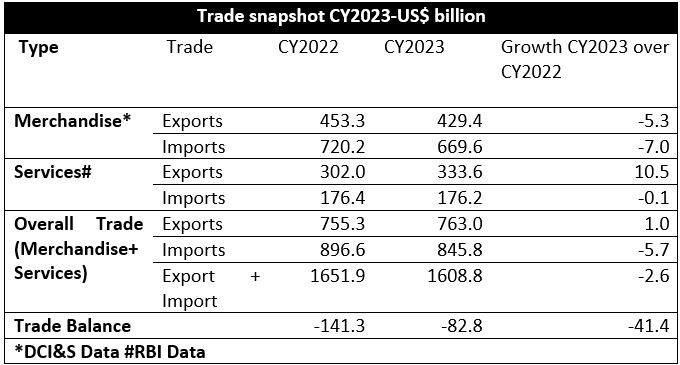
India’s exports 2023: India’s foreign trade numbers in 2023 present a complex picture, reflecting both the global economic environment and specific domestic challenges and opportunities. The Department of Commerce’s November 2023 trade statistics, combined with data from UNCTAD and the WTO, provide a detailed insight into the nuances of India’s trade performance during the year.
A key feature of India’s trade in 2023 is a 5.3% decline in merchandise exports. This downturn, notably occurring against the backdrop of a depreciating rupee, contradicts the usual economic expectation where a weaker currency often boosts export competitiveness. The decline in exports, particularly in labour-intensive sectors like textiles and leather, can be attributed to a combination of internal and external factors, including high production costs, delays at ports, and a global slump in demand, says a report by Global Trade Research Initiative.
READ I Indian banks can reimagine global financial services
India’s exports get electronics boost
Contrasting the general downtrend, the electronics sector, especially smartphone exports, displayed remarkable growth. This can be seen as a direct outcome of focused initiatives to bolster electronics manufacturing in India. The success in this sector underscores the potential benefits of targeted support and investment in other sectors, particularly those dominated by small and medium enterprises that are currently facing cost disadvantages.
India’s overall foreign trade crossed the $1609 billion mark in 2023, a slight decrease from the previous year. While merchandise exports declined, this was somewhat offset by a 10.5% growth in services exports. This mixed picture is reflective of broader global trends, with a simultaneous decline in both exports and imports in the merchandise sector but relative stability in the services sector.

At the product level, the majority of India’s merchandise exports, constituting 78% of the total value, faced a decline. Key sectors like engineering goods, petroleum products, and textiles were among those that saw reduced export volumes. In contrast, certain high-value export products like aviation turbine fuels, motor gasoline, and smartphones experienced growth, highlighting areas of emerging strength and potential for India’s export economy.
India’s export basket needs not only focused support for high-potential sectors like electronics but also a strategic push for diversification within existing sectors. Encouraging greater value chain integration, especially in labor-intensive sectors like textiles and leather, can boost their competitiveness. This could involve supporting the development of ancillary industries, skill development for advanced manufacturing, and fostering partnerships with global brands.
Strengthening electronics manufacturing
The significant increase in smartphone exports and overall growth in the electronics sector is a testament to India’s strengthening capabilities in electronics manufacturing. However, the continued growth in imports of electronic components indicates a reliance on foreign sources for critical inputs, even as imports of finished electronic products like computers and laptops declined. This trend suggests a gradual shift towards greater self-reliance in electronics manufacturing, supported by initiatives like the Production-Linked Incentive (PLI) scheme.
The export of petroleum products saw a decline in 2023, contrasting with an increase in imports of petroleum crude. This suggests a complex interplay of domestic production capacities and global energy market dynamics, which continue to impact India’s trade balance in this crucial sector.
Detailed estimates for 2023
GTRI’s projections based on past data and global forecasts paint a picture of negative growth in both merchandise exports and imports, with a notable exception in the services sector, which showed a robust increase in exports. The overall trade balance improved significantly, thanks in part to a larger decrease in imports compared to exports.
The success of the electronics sector demonstrates the effectiveness of proactive policies and targeted incentives. Optimizing free trade agreements (FTAs) can further unlock opportunities in key markets. Additionally, addressing logistical bottlenecks – from port congestion to inadequate road infrastructure – will significantly reduce export costs and improve lead times.
India’s export portfolio shows varied performance across different product groups. While 13 out of 30 product groups showed positive growth, the majority faced a decline. This indicates a need for a strategic reorientation towards sectors with growth potential while addressing challenges in those that are lagging.
The global context
The decline in global trade in 2023 is attributed to a confluence of factors including high inflation, interest rate hikes, geopolitical tensions, energy and commodity price volatility, China’s economic slowdown, and the introduction of the EU’s Carbon Border Adjustment Mechanism. These global dynamics have a direct bearing on India’s trade performance, highlighting the interconnected nature of modern economies.
India’s foreign trade in 2023 was characterised by significant challenges, particularly in the merchandise sector, but also showed areas of strength and potential. The electronics sector, in particular, stands out as a success story, signaling the benefits of focused policy interventions. However, to harness the full potential of its trade capabilities, India needs to address the systemic issues facing its labour-intensive sectors and adapt to the rapidly evolving global economic landscape.
As global dynamics become increasingly complex, India needs to build resilience in its trade ecosystem. This involves diversifying trading partners, exploring new markets, and strengthening domestic production capacities. Embracing green trade practices and aligning with global sustainability initiatives can create new export opportunities and enhance India’s image as a responsible trading partner.
